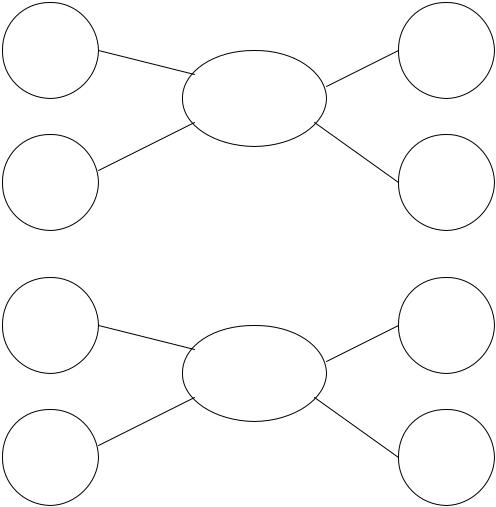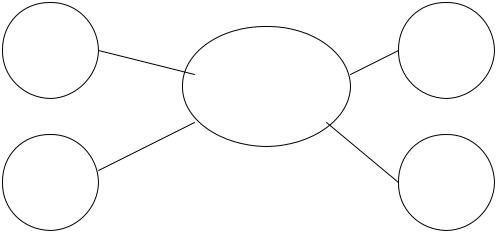
7530
.pdf
41
средневековому зодчеству, применять передовые строительные технологии,
металлический свод, прочные и вместительные подвалы, золотой запас империи; выходящий; облицованный резным камнем; расписанный фресками, эскиз, выполнять, жилой дом, разнообразный, обычный, жилище,
псевдо-модернистский, принести славу местным архитекторам,
примыкающий, забежать (заглянуть), не пропустить, книги о местной истории, пропорциональность застройки, городская окраина, отопление,
развеваться на ветру, бедные вдовы и сироты.
4. Fill in the diagram:
Styles
Dwellings

42
Decorations
5. Translate the text into English.
Молчаливый наблюдатель
В последней четверти ХIХ века мещанин Ф. Е. Приспешников,
выходец из Макарьева, купил в Нижнем, на Большой Покровской,
двухэтажный каменный дом, который появился здесь еще в конце 1840-х
годов; а затем в 1873—1875 годах пристроил к нему двухэтажный флигель.
По-видимому, дела у Приспешникова шли хорошо, потому что к 1894
году по проекту известного нижегородского архитектора Н. Д. Григорьева он увеличил на один этаж флигель и пристроил к нему еще один трехэтажный красного кирпича корпус, оформив тем самым угол улиц Большой Покровской и Грузинской.
Архитектор объединил здание «единой фасадой», и, проходя мимо него, мы даже и не догадываемся, что дом этот сложен из разных «кубиков».
Срезанный угол дома придает ему парадный вид. Наверху — полуциркульное окно. На третьем этаже — балкон с ажурной решеткой.
43
Раньше такой же был и на втором. Изначально парадный вход тоже был отсюда — со срезанного угла.
Дом всегда использовался как доходный, то есть его площади сдавались в аренду. На первом этаже находился «Винно-гастрономический и колониальный магазин Ф. И. Кубасова». На втором этаже с 1895 по 1917 год размещалась редакция местной газеты «Нижегородский листок».
В течение семи лет в этой редакции активно работал Максим Горький.
Особенно плодотворной была его работа во время Всероссийской выставки
1896 года. За семь месяцев М. Горький опубликовал свыше 50 материалов:
фельетоны, отчеты с выставки, несколько рассказов.
Газета объединила лучших писателей России.
Здесь же, в доме, находилась квартира редактора С. И. Гриневицкого, в
которой запросто собирались известные писатели В. Г. Короленко, Н. Г.
Гарин-Михайловский, Л. Н. Андреев. Пели хором, Степан Петров (Скиталец)
играл на гуслях. Видели стены дома и как копились здесь теплые вещи,
продукты, книги, которые шли в помощь беднякам и сосланным в Сибирь революционерам.
В этом доме глубокие и большие подвалы, которые часто использовались как складские помещения, а во время пребывания здесь
«Нижегородского листка» и в первые годы советской власти в них выполнялись типографские работы.
Первый этаж изначально использовался как магазин. Магазины имели разное назначение, но, пожалуй, дольше всех здесь висела вывеска
«Продукты», и нижегородцы (а точнее, горьковчане) звали ласково этот гастроном по номеру — « Тринадцатым». В другой части дома были пельменная и молочный магазин.
После революции внутри дома провели перепланировку: большие комнаты перегородили, устроили «коммуналку» со всеми ее атрибутами — одной кухней, одним туалетом на несколько семей. Однако, по воспоминаниям жильцов, жили дружно.
44
Так дом практически без больших ремонтов дожил до середины 1980-х.
И на центральной улице города за красивым фасадом шла неустроенная бытовая жизнь — частично с печками, частично с АГВ.
Но вот в здании был проведен ремонт, квартиры благоустроили, часть жильцов расселили. Внизу открылись новые магазины, а на срезанном торце здания, прямо под старинным ажурным балконом, обосновался продовольственный киоск.
Так получилось, что видел этот дом и конные экипажи, и трамвайные пути, видел и троллейбусы, автобусы и автомашины самых разных (в
основном отечественных) марок.
А теперь улица Большая Покровская — только для пеших прогулок. И
дом порой кажется молчаливым и пристальным наблюдателем за нами,
сегодняшними...
Какие мы?..
Что еще увидит этот дом?..
Меняются времена, меняются нравы, меняется мода, меняется сама
жизнь...
6. Speaking. Give a guided tour of the street.
45
LESSON 8. THE KREMLIN
1.Lead in
1)What remarkable buildings are situated in the Nizhny Novgorod Kremlin?
2)What towers of the Kremlin do you know?
3)What is your favourite spot in the Kremlin? Why?
2. Reading Read the article and answer the following questions:
1)What makes the Kremlin very picturesque?
2)What is the Church of John the Baptist famous for?
3)When was the Kremlin erected?
4)Who was its architect?
5)How many towers are there?
7)What legends are connected with them?
8)What buildings are located in the territory of the Kremlin?
THE NIZHNY NOVGOROD KREMLIN
The Nizhny Novgorod Kremlin is the most fascinating place of the city. One can spend the entire day here visiting the landmarks and museums, and then just strolling along the vast area. The location on different height levels of the hill, the greenery, the surprising views of the Volga, — all of these make the Kremlin very picture sque. The great merit of the Kremlin is its being an integrated whole with the surroundings, and preserving both the medieval sternness of its walls and towers and classicism features of the XIXth century structures.
Before we proceed to the Kremlin, a good option will be to come closer to a three-storeyed brick house on the slope. This is the former merchant Bugrov's shelter (lodging house) that is very well known from M. Gorky's play «At the bottom». The former «Stolby» teahouse located near by in the building with a six-column portico also has reference to the name of the writer. It was opened in 1901 by the local intelligentsia for the needy. The building was constructed in the 30s of the previous century on G.
46
Kizewetter's project right at this place, close to the Church of John the Baptist (its initial appearance has been changed immensely by the time and people), there is one of the most famous localities of the history of Nizhny Novgorod. According to a legend, in 1612 on that spot K. Minin addressed his townspeople with a call to start a military campaign to liberate Moscow captured by Polish and Lithuanian invaders.
The church was reconstructed and the new ensemble appeared in the place in 2005. It was opened on 4th of November, 2005.
We are entering the Kremlin through the Ivanovskaya tower that served as a primary defense point for the Nizhny posad (lower residential area), and going up Kremlyovsky slope. Centuries ago this slope was paved with the tarred wood, and later with cobblestones. The slope used to be very significant strategically connecting the upper and the lower part of the city till the 30s of the XIXth century, when Zelensky slope was laid. After that Kremlin slope became the main entrance to the city, and Zelensky slope acquired a status of the primary transportation artery. The root of the word «Zelensky», «zelye», originally meant «gunpowder», which was stored in the hiding-places of the slope. The stone Nizhny Novgorod Kremlin was erected in 1500. The main purpose of it was to protect northeastern Russia from enemies' raids. In 1508, Peotr Fryazin, an Italian architect (that was the name Russians called him) came to Nizhny Novgorod to construct the Kremlin. He is also known to have built a number of structures in the Moscow Kremlin. Under his supervision the Nizhny Novgorod Kremlin was erected in accordance to all of the fortification requirements of those times. A moat was dug, and the builders provided the opportunity to employ artillery crossfire capability from the towers.
The Dmitrivskaya tower functioned as a major defense stronghold of the Verkhniy posad (Upper residential area). That was the point from which construction of the stone Kremlin was commenced. The
47
tower had a bridge connection with a fortified fire point set up over the moat. In 1896, the Art and History museum was opened in the tower.
For that goal a «light lantern», which tent is presently decorated with the deer (city's coat of arms), was constructed by N. Sultanov, a metropolitan architect.
Round in shape, the Kladovaya (Pantry) tower is situated next to the Dmitrievskaya tower. That is the starting point of excursions about the Kremlin wall.
The square communicating the Nicholskaya tower has retained up till now the apertures for the chains lifting a drawbridge, which was connected with the wooden bridge stretched over the moat. Nowadays there is a bridge over Zelensky slope connecting Kremlyovsky Boulevard with Teatralnaya square.
The neighboring Koromyslova tower has a very interesting legend. The enemy vanguard encountered a girl who was going to get water. She defended herself with a yoke thus turning them into flight. The foe thought that if women of that city were so brave, then it would be better not to mess up with local men, and withdrew.
By the Tainitskaya tower, at the foot of the wall you can still observe the original white-brick fragments of the wall. We also should make a comment here that the contemporary upper parts of the Kremlin wall and the battlements were partially restored a few years ago. An especially beautiful view of the Nizhny posad, the Strelka (rivers' confluence) and the plains over the river opens to traveler's eye from the observation terrace by the Severnaya tower. The neighboring to it Chasovaya tower, round in shape with three tiers, is one of the most picturesque towers of the fortress. In the past a clock with bells was mounted on its top.
The Belaya, Zachatyevskaya (Holy Conception) and Borisoglebskaya towers in the northern part of the Kremlin got persistently
48
ruined by the landslides and in the XIXth century they were dismantled. During the renovation thirty years ago the Belaya and Borisoglebskaya towers were restored.
The nearest to the embankment Georgievskaya tower also functioned as a thoroughfare; however, its gate was not used at times of peace. It served for making sallies during a siege. The massive piers make the tower more attractive. Having had a look at the fortress you might want to come up closer to the Cathedral of Archangel Michail erected in 1631 under the guidance of Lavrentiy Vozoulin (the apprentice of stone-craft, and Antipa, his stepson). It was built on the spot where the grand dukes' cathedral previously stood (1359). Before that there had been a church founded in 1227 (it replaced another wooden church built simultaneously with the foundation of the city). The present-day cathedral was constructed to commemorate the victory of the volunteer army led by Minin and Pozharsky. The appearance of the building corresponds to its memorial nature. The cathedral tent roof resembles wooden churches of the Russian North. The proportionality of all its elements proves the architect's great skill.
The cathedral was on fire many times and that resulted in numerous changes in its architecture.
In 1962 after the restoration Kozma Minin's remains were buried here. Before that they had been in the Spassky-Preobrazhensky cathedral of the Kremlin, which was dismantled in 1929.
In the late XVIIIth century the Kremlin was essentially rebuilt. Older constructions were demolished and a plaza was laid out by the Archangel cathedral. On one side of the plaza the Presence Seats were allocated (1782-1785, architect V. Ananyin). The portico columns and the attic (a stair-like roof edge) emphasize the classical style of the building.
49
The Palace of the Vice-governor, built on the opposite side of the plaza, in many ways repeats the architectural style of the Presence Seats. As deemed by the architect, it was to become a part of a vast ensemble.
On the other side of the Michail Archangel Cathedral the obelisk to Minin and Pozharsky was placed in 1828. The public financed its construction; the funds were raised through subscription. The granite slabs of the monument were brought here from Karelia. Its facets were decorated with bas-reliefs cast from sketches of I. Martos, sculptor of the monument to Minin and Pozbarsky in the Red Square in Moscow. At a short distance there is the Eternal Flame and a memorial to those who died during the World War (1941-1945).
Here you can often encounter just married couples who lay flowers to the monuments. If we return to the Dmitrievskaya tower (there you can observe the exhibition of military vehicles that were produced at the city plants in the course of the Great Patriotic war) and go to the eastern part of the Kremlin the House of Soviets (1929-1931, architect A. Grinberg) will attract our attention. It is one of the best samples of the constructionist architecture in Nizhny Novgorod. The House is remarkable for a protruding semi-cylinder with a belt glazing. It was nicknamed as plane due to the evident similarity to a plane if we look at it from above. In the Governor's Palace (1835-1841) located near by there is now the Art Gallery, which possesses a rich collection of icons and paintings by the Peredvizhhniks («Movers», the XIXth century Russian realist school) as well as an impressive compilation of the Russian avant-garde paintings.
Beyond the Gallery, on the slope of the hill there is Kremlyovsky Gardens. Though it is desolate it still remains luring to those who enjoy romantic walks.

50
3. Read the text again and find English equivalents for the
following Russian words and phrases:
средневековая суровость; значительно, изображенный, мощенный,
просмоленное дерево, булыжник, ров, перекрестный огонь, пункт обороны, стрельница, световой фонарь, шатер, столичный, проушины,
коромысло, противник, отступать, контрфорсы, осада, вылазки гарнизона, в память, соразмерность, высокое мастерство зодчего,
существенно перепланирован, разобрать, портик, аттик, ступенчатое завершение крыши.
4. Fill in the chart of the Nizhny Novgorod Kremlin towers:
Name |
Age |
Shape |
Historical |
Legends |
events
